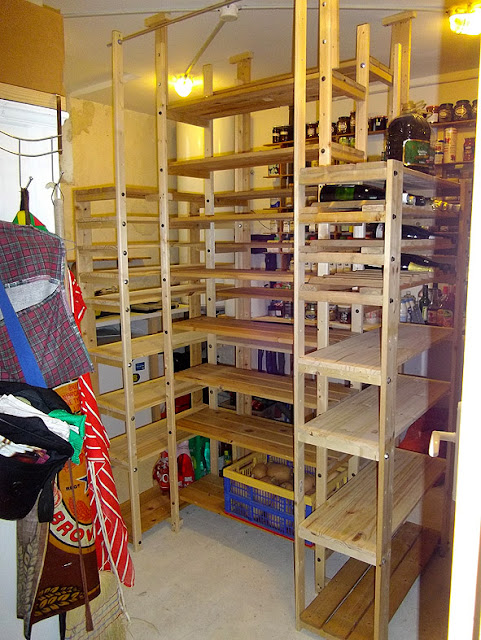but....
at last the cellier is almost complete...
The underfloor heating is connected up [and working] so the final wall area could be completed with a worktop and the fridges underneath.
 |
| This is what the sides looked like before the view was obscured. |
now...
the Tower of Gorm* is finished!
We brought with us the IKEA wooden shelving from our cellar in Leeds.
 |
| The basic frame with the new rails. |
The German family we sold the house to didn't want anything left behind!
And we mean ANYTHING!!
They even wanted us to clear out the kitchen units... BEFORE completion!?!
Oh yes?... we thought not!! What if the sale hadn't completed?
But... apparently that's the way it is done in Germany... you move lock, stock, barrel, hinges, doors, light fittings and the kitchen sink! But we think Peter was glad we didn't remove the sink... he ended up camping in the house for nine months to work on and oversee the conversion... which was difficult. He was trying to leave a lot of the original features we had kept.... but bring the house up to modern insulating standards... very difficult to leave ornate architrave and cornices and insulate the walls they are on!
So, along with everything else we brought the IKEA shelving.
And a wardrobe and a tallboy.... because the charity shops didn't want them!
But we are very glad we did... everything that is 'reasonably' priced in France seems to be made of MDF with a paper 'skin' that is printed to look like wood.
We like real wood... something solid [massif], preferably, or a good, thick, wood veneer if not, over plywood, good chipboard or thick MDF. Something that doesn't date too much as well.
But the shelving was intended to come with us... [I just felt like having a rant there! Tim]
Our excuse... it is a dull, grey morning after a rainy windy night...
 |
| Shelves in place- a few bottles there to test the important bit! |
The new shelves are solid, not bars, as we are using the 7€50 pine planks from the brico. This will be very useful for the beer and the small jar shelves as things tended to tip into the gaps 'twixt the bars before [and often created a domino effect].
Some of the "more room" replaces the metal shelving that had to go to the tip before we left... it was so rusty, weak and flimsy that we'd started to store empty bottles on it to lighten the loading. Empties will now be stored in the grange in those boxes that moved our preserves, wine and beers.
We only brought back a few bottles of wine that had been purchased over here... didn't quite get the purchase/consumption level correct there... shoulda bin zero!
 |
| These are some of the home-made shelves... these are spaced for small bottles. |
Then we can start emptying the boxes full of conserves, pickles and instant ice-cream mixes [just add creme fraiche or yoghurt before using the machine]. The latter came around by accident... jams that just wouldn't set... but now stuff gets bottled deliberately at the halfway stage.... after a disaster with a dead freezer and the new one that was delivered.... dead! Another reason we are so keen on older methods of preserving... and part of the reason for choosing France, where, apart from the USA, everywhere seems to sell the equipment and chemicals you need. But we haven't found a source for sausage skins or saltpetre yet... anyone?
 |
| All shelves in, filling up fast... |
And the "Rise of the Island of Sten" just doesn't have the same ring to it!!
More Gorm will most likely be purchased to store 'stuff' [Pauline's term for things Tim has in boxes] if we can brave a trip to IKEA in Tours.




